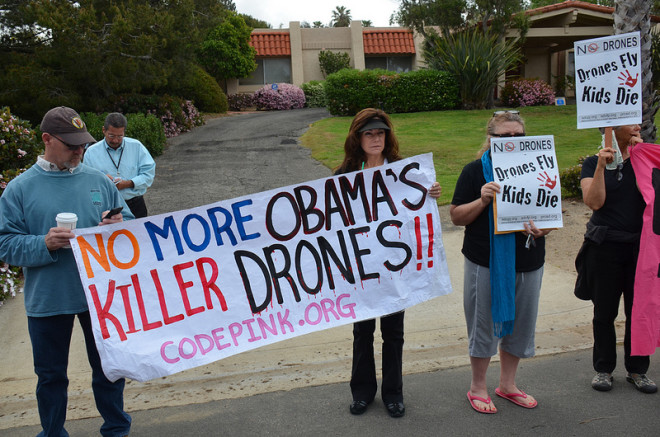Drones, Death and the Aftermath
BY MAAZ AHMAD
On March 17, 2011, a “Jirga”, or tribal assembly of elders, was held in Datta Khel, a town in northern Pakistan, to resolve a dispute over a chromite mine. Organized in an open space and in broad daylight, the Jirga was brought to the attention of Pakistani military commanders 10 days in advance. Soon after it began, a drone struck. There was flesh, blood and debris everywhere and, in a matter of seconds, 40 tribal elders were eliminated. The community was devastated.
While speaking at Johns Hopkins University three months later, John Brennan, the US’s then chief counter-terrorism advisor unashamedly claimed: “In the past year, there hasn’t been a single collateral death because of the exceptional proficiency, precision and capabilities we have developed.”
Human Costs:
Since the first US drone strike in Pakistan in 2004, “drone attacks” have been a controversial subject for both the intelligentsia and the general public around the globe. A large majority of Pakistanis question the legitimacy and effectiveness of drone strikes as well as their human costs. Evidence compiled by the Bureau of Investigative Journalism suggests that an estimated 3,300 people have been killed by drone strikes in Pakistan. Appallingly enough, only 2% of these have been identified as ‘high-profile targets’. The rest of them fall into the category of ‘collateral damage’ and were either children, civilians or ‘alleged combatants’. The Bureau of Investigative Journalism reports that at least 176 victims were children.
Entire communities in the war-torn Pakistani region of F.A.T.A (Federally Administered Tribal Areas) live under perpetual fear of drone strikes. The residents suffer from Posttraumatic Stress Disorder (PTSD) primarily due to the fact that they feel under threat of potential attack 24 hours a day, 7 days a week. Residents of F.A.T.A have experienced a sharp rise in mental illnesses including anxiety and other psychological disorders. Many of them frequently have to make the trip to Peshawar (the nearest city) to be treated by psychiatrists and psychologists.
The phenomena of ‘double-tapping’ compounds these issues. This technique is frequently employed by drone operators and involves back-to-back strikes on the same target. Between the first and the second strikes, doctors, neighbors or family members of the victims often gather to assist the injured. Soon afterwards, however, the second strike kills many of them. This reality now prevents immediate medical assistance for victims as medics are horrified of the ‘second tap’.
Counter-Productiveness and anti-Americanism:
In the Pakistani discourse on drone attacks, the question of counter-productiveness often resonates. Most Pakistanis argue that the unjust way in which drone strikes operate is counter-productive in this “battle of hearts and minds”. Not only do they fuel general anti-Americanism in Pakistan, drone strikes also make it easier for terrorist outfits to sell their narrative of “Jihad”. Every drone strike produces potential recruits or suicide bombers; terrorist groups offer an outlet through which these damaged individuals can channel their anger and desire for revenge. As David Kilcullen (former advisor to General David Petraeus) puts it: “Every one of these dead non-combatants represents an alienated family, a new desire for revenge, and more recruits for a militant movement”.
A vicious circle of death and destruction is now in place in Pakistan. Drone strikes stimulate militancy as well as suicide attacks on civilians, military personnel and government officials. The common Pakistani questions why they have to pay multiple prices for being an ally of the United States in the war against terrorism. Not only is Pakistani airspace violated by its ‘ally’, undermining its sovereignty, but the aftermath is also borne by common Pakistanis. The frequency of terrorist attacks in Pakistan rises sharply after drone attacks in the tribal areas. The Bajaur Agency drone attack is a prime example of such retaliation faced by Pakistanis. This strike took place on October 30, 2006 on a madrassa (school of religious instruction). It killed 82 people, mostly children. 9 days later, a suicide bomber killed 42 Pakistani soldiers and left another 20 severely injured.
US policy makers must realize that for every terrorist they kill through drone strikes, they produce a dozen more. Although these strikes have been partially successful in eliminating a few high-value targets, they have had huge humanitarian costs. Simultaneously, they severely undermine the efforts of organizations like USAID to improve the public perception of United States amongst Pakistanis. As mentioned above, not only do the strikes help create new recruits for the Pakistani Taliban, they provide an ideological boost for them. The tribal inhabitants of F.A.T.A are easily convinced that the ‘War against Terrorism’ is actually a ‘War against Islam”. If President Obama really believes in ‘a new beginning between Muslims and the United States’, as envisaged in his Cairo speech in 2009, he most certainly needs to revisit his policy on drones.
